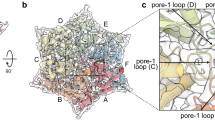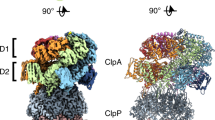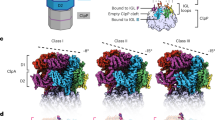Abstract
In the AAA+ ClpXP protease, repetitive cycles of ATP hydrolysis by ClpX unfold ssrA-tagged substrates, which are unraveled vectorially starting at the C-terminal tag and translocated into ClpP for degradation. When the ATP-hydrolysis rate drops below a critical threshold, ClpXP fails to degrade ssrA-tagged green fluorescent protein (GFP) but degrades other tagged proteins, including some that are more stable. Our results support a model in which ClpX unfolding of GFP progresses via a metastable short-lived intermediate, which must be captured by several fast ATP-dependent translocation steps to prevent the protein from refolding and therefore escaping degradation. Thus, AAA+ proteases may be more or less suited to degradation of specific substrates depending on their ability to disrupt native structure and to trap partially unfolded intermediates successfully. We propose that cellular conditions or adaptors that alter ATP-hydrolysis rates could control this trapping activity of AAA+ enzymes.
This is a preview of subscription content, access via your institution
Access options
Subscribe to this journal
Receive 12 print issues and online access
$189.00 per year
only $15.75 per issue
Buy this article
- Purchase on Springer Link
- Instant access to full article PDF
Prices may be subject to local taxes which are calculated during checkout




Similar content being viewed by others
References
Gottesman, S., Roche, E., Zhou, Y. & Sauer, R.T. The ClpXP and ClpAP proteases degrade proteins with carboxy-terminal peptide tails added by the SsrA-tagging system. Genes Dev. 12, 1338–1347 (1998).
Herman, C., Thévenet, D., Bouloc, P., Walker, G.C. & D'Ari, R. Degradation of carboxy-terminal-tagged cytoplasmic proteins by the Escherichia coli protease HflB (FtsH). Genes Dev. 12, 1348–1355 (1998).
Sauer, R.T. et al. Sculpting the proteome with AAA+ proteases and disassembly machines. Cell 119, 9–18 (2004).
Lee, C., Schwartz, M.P., Prakash, S., Iwakura, M. & Matouschek, A. ATP-dependent proteases degrade their substrates by processively unraveling them from the degradation signal. Mol. Cell 7, 627–637 (2001).
Kenniston, J.A., Baker, T.A., Fernandez, J.M. & Sauer, R.T. Linkage between ATP consumption and mechanical unfolding during the protein processing reactions of a AAA+ degradation machine. Cell 114, 511–520 (2003).
Andersen, J.B. et al. New unstable variants of green fluorescent protein for studies of transient gene expression in bacteria. Appl. Environ. Microbiol. 64, 2240–2246 (1998).
Weber-Ban, E.U., Reid, B.G., Miranker, A.D. & Horwich, A.L. Global unfolding of a substrate protein by the Hsp100 chaperone ClpA. Nature 401, 90–93 (1999).
Kim, Y.I., Burton, R.E., Burton, B.M., Sauer, R.T. & Baker, T.A. Dynamics of substrate denaturation and translocation by the ClpXP degradation machine. Mol. Cell 5, 639–648 (2000).
Singh, S.K., Grimaud, R., Hoskins, J.R., Wickner, S. & Maurizi, M.R. Unfolding and internalization of proteins by the ATP-dependent proteases ClpXP and ClpAP. Proc. Natl. Acad. Sci. USA 97, 8898–8903 (2000).
Herman, C., Prakash, S., Lu, C.Z., Matouschek, A. & Gross, C.A. Lack of a robust unfoldase activity confers a unique level of substrate specificity to the universal AAA protease FtsH. Mol. Cell 11, 659–669 (2003).
Kwon, A.R., Trame, C.B. & McKay, D.B. Kinetics of protein substrate degradation by HslUV. J. Struct. Biol. 146, 141–147 (2004).
Choy, J.S., Aung, L.L. & Karzai, A.W. Lon degrades transfer-messenger RNA-tagged proteins. J. Bacteriol. 189, 6564–6571 (2007).
Doyle, S.M. et al. Asymmetric deceleration of ClpB and Hsp104 ATPase activity unleashes protein-remodeling activity. Nat. Struct. Mol. Biol. 14, 114–122 (2007).
Burton, R.E., Siddiqui, S.M., Kim, Y.I., Baker, T.A. & Sauer, R.T. Effects of protein stability and structure on substrate processing by the ClpXP unfolding and degradation machine. EMBO J. 20, 3092–3100 (2001).
Burton, R.E., Baker, T.A. & Sauer, R.T. Energy-dependent degradation: linkage between ClpX-catalyzed nucleotide hydrolysis and protein-substrate processing. Protein Sci. 12, 893–902 (2003).
Hersch, G.L., Burton, R.E., Bolon, D.N., Baker, T.A. & Sauer, R.T. Asymmetric interactions of ATP with the AAA+ ClpX6 unfoldase: allosteric control of a protein machine. Cell 121, 1017–1027 (2005).
Martin, A., Baker, T.A. & Sauer, R.T. Rebuilt AAA+ motors reveal operating principles for ATP-fueled machines. Nature 437, 1115–1120 (2005).
Kenniston, J.A., Baker, T.A. & Sauer, R.T. Partitioning between unfolding and release of native domains during ClpXP degradation determines substrate selectivity and partial processing. Proc. Natl. Acad. Sci. USA 102, 1390–1395 (2005).
Kenniston, J.A., Burton, R.E., Siddiqui, S.M., Baker, T.A. & Sauer, R.T. Effects of local protein stability and the geometric position of the substrate degradation tag on the efficiency of ClpXP denaturation and degradation. J. Struct. Biol. 146, 130–140 (2004).
Bolon, D.N., Grant, R.A., Baker, T.A. & Sauer, R.T. Nucleotide-dependent substrate handoff from the SspB adaptor to the AAA+ ClpXP protease. Mol. Cell 16, 343–350 (2004).
Dietz, H. & Rief, M. Exploring the energy landscape of GFP by single-molecule mechanical experiments. Proc. Natl. Acad. Sci. USA 101, 16192–16197 (2004).
Mickler, M. et al. Revealing the bifurcation in the unfolding pathways of GFP by using single-molecule experiments and simulations. Proc. Natl. Acad. Sci. USA 104, 20268–20273 (2007).
Li, H., Carrion-Vazquez, M., Oberhauser, A.F., Marszalek, P.E. & Fernandez, J.M. Point mutations alter the mechanical stability of immunoglobulin modules. Nat. Struct. Biol. 7, 1117–1120 (2000).
Best, R.B. et al. Mechanical unfolding of a titin Ig domain: structure of transition state revealed by combining atomic force microscopy, protein engineering and molecular dynamics simulations. J. Mol. Biol. 330, 867–877 (2003).
Flynn, J.M. et al. Overlapping recognition determinants within the ssrA degradation tag allow modulation of proteolysis. Proc. Natl. Acad. Sci. USA 98, 10584–10589 (2001).
Reid, B.G., Fenton, W.A., Horwich, A.L. & Weber-Ban, E.U. ClpA mediates directional translocation of substrate proteins into the ClpP protease. Proc. Natl. Acad. Sci. USA 98, 3768–3772 (2001).
Martin, A., Baker, T.A. & Sauer, R.T. Distinct static and dynamic interactions control ATPase-peptidase communication in a AAA+ protease. Mol. Cell 27, 41–52 (2007).
Joshi, S.A., Hersch, G.L., Baker, T.A. & Sauer, R.T. Communication between ClpX and ClpP during substrate processing and degradation. Nat. Struct. Mol. Biol. 11, 404–411 (2004).
Brejc, K. et al. Structural basis for dual excitation and photoisomerization of the Aequorea victoria green fluorescent protein. Proc. Natl. Acad. Sci. USA 94, 2306–2311 (1997).
Levchenko, I., Seidel, M., Sauer, R.T. & Baker, T.A. A specificity-enhancing factor for the ClpXP degradation machine. Science 289, 2354–2356 (2000).
Acknowledgements
We thank D. Wagner and K. Weiss for performing the initial experiments, K. Wang for ClpA and P. Chien, A. Horwich, J. Kenniston, A. Matouschek and F. Schmid for helpful discussions. Supported by the US National Institutes of Health grant AI-15706. A.M. was supported by a Merck/MIT CSBi postdoctoral fellowship. T.A.B. is a Howard Hughes Medical Institute employee.
Author information
Authors and Affiliations
Contributions
A.M. designed and performed experiments; A.M., T.A.B. and R.T.S. analyzed data and wrote the manuscript.
Corresponding author
Rights and permissions
About this article
Cite this article
Martin, A., Baker, T. & Sauer, R. Protein unfolding by a AAA+ protease is dependent on ATP-hydrolysis rates and substrate energy landscapes. Nat Struct Mol Biol 15, 139–145 (2008). https://doi.org/10.1038/nsmb.1380
Received:
Accepted:
Published:
Issue Date:
DOI: https://doi.org/10.1038/nsmb.1380
This article is cited by
-
The molecular principles governing the activity and functional diversity of AAA+ proteins
Nature Reviews Molecular Cell Biology (2020)
-
Site-specific ubiquitination affects protein energetics and proteasomal degradation
Nature Chemical Biology (2020)
-
Topologically knotted deubiquitinases exhibit unprecedented mechanostability to withstand the proteolysis by an AAA+ protease
Scientific Reports (2018)
-
Engineered AAA+ proteases reveal principles of proteolysis at the mitochondrial inner membrane
Nature Communications (2016)
-
Mechanistic insights into bacterial AAA+ proteases and protein-remodelling machines
Nature Reviews Microbiology (2016)



